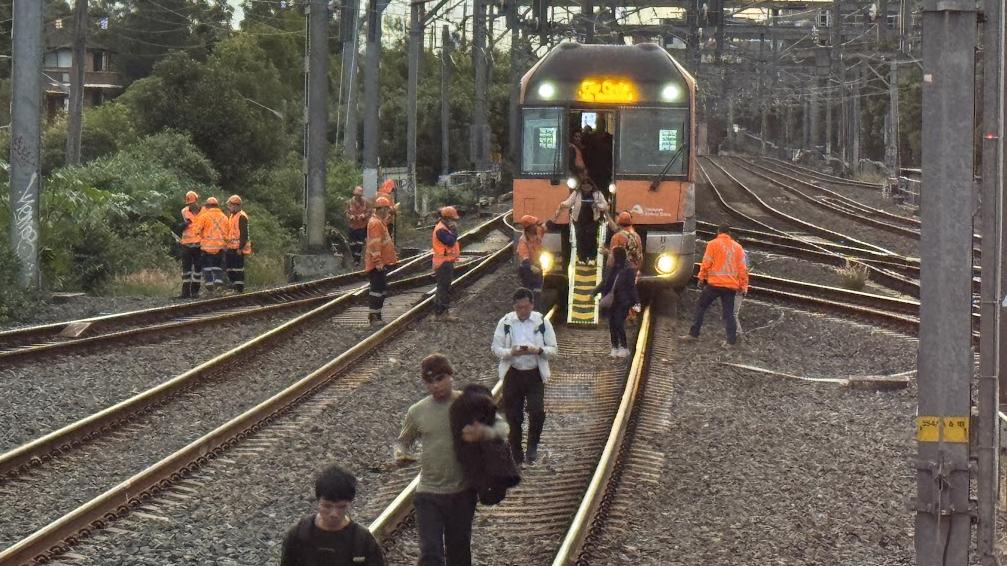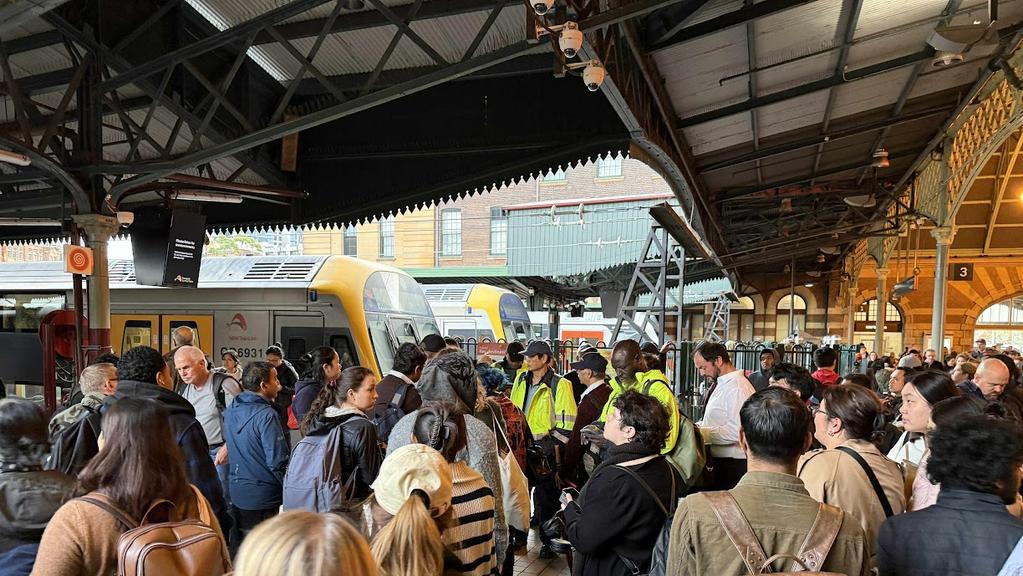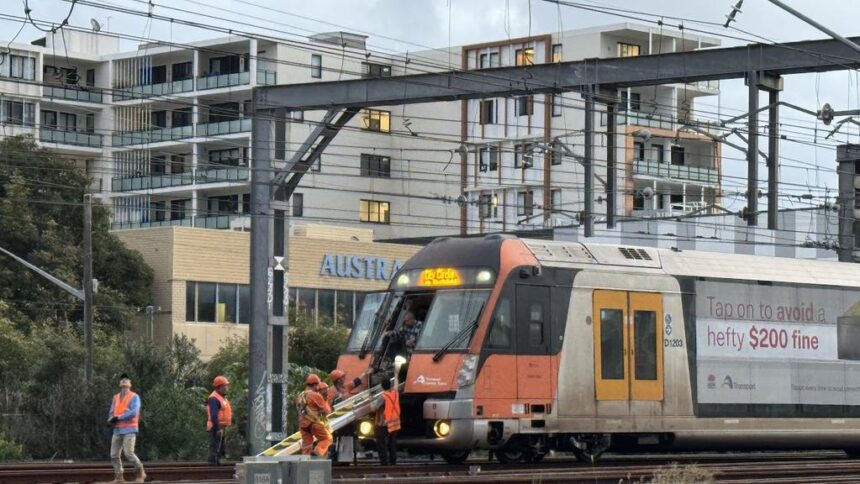Sydney Train Chaos Leaves Commuters Stranded Amid Peak-Hour Power Fault
Sydney train chaos erupted on Tuesday afternoon as widespread power and wiring failures shut down key rail services just before peak hour, leaving thousands of commuters stranded and scrambling for alternatives. The incident crippled operations on the T1, T2, T3, and T9 lines, sparking delays, overcrowding, and frustration across the city’s transport network.
Overhead Wire Snag Triggers Systemwide Rail Delays
Authorities confirmed the disruption stemmed from a mechanical failure that damaged part of a train’s rooftop power connector. The equipment tangled with overhead electrical wires, pulling down live cables near Homebush around 2:30 PM. The fault immediately rendered the section of track between Central and Homebush unsafe, bringing train movement to a grinding halt.
One Train Immobilized with 300 Passengers Aboard
One of the most severe consequences of the power fault near Homebush was a train that became immobilized mid-route with approximately 300 passengers trapped onboard. Riders were left without clear updates, confined inside the stationary train from 2:45 PM until just after 5 PM, prompting serious concern over emergency management protocols.
Commuters Advised to Use Alternate Routes
As the issue unfolded, Transport for NSW urged passengers to plan for longer travel times and consider other forms of transport. The ripple effect of the commuter disruption was felt at major stations across Sydney, with cascading delays and platform congestion frustrating thousands attempting to travel home.
Safety Protocols Prioritized During Response
Howard Collins, Transport for NSW’s Co-ordinator, briefed the media throughout the afternoon, emphasizing that passenger safety remained the top priority. Emergency services worked alongside transport officials to cut power, stabilize the affected area, and safely evacuate those trapped on the disabled train. “We had to make sure the overhead system was safe before we could act,” Collins stated.
Infrastructure Incident Highlights System Vulnerability
The unexpected breakdown not only exposed the physical fragility of Sydney’s transport infrastructure but also highlighted the city’s growing reliance on tightly scheduled rail services. With peak-hour demand already surging, even minor faults can lead to major system breakdowns and ripple effects lasting for hours.
Restoration Work Ongoing, Investigations Underway
While services resumed in phases later in the evening, delays continued well into the night. Investigations into the mechanical fault and wiring damage are now underway. Transport authorities aim to determine whether equipment fatigue, human error, or broader systemic issues played a role.
Passengers Demand Accountability and Transparency
For many affected by the Sydney train chaos, frustration quickly turned into demands for greater transparency. Social media platforms were flooded with complaints from commuters left without clear information, and calls are growing for better contingency planning and real-time communication tools.

Sydney Train Chaos Leaves Commuters Stranded Amid Peak-Hour Power Fault
Sydney train chaos erupted on Tuesday afternoon as widespread power and wiring failures shut down key rail services just before peak hour, leaving thousands of commuters stranded and scrambling for alternatives. The incident crippled operations on the T1, T2, T3, and T9 lines, sparking delays, overcrowding, and frustration across the city’s transport network.
Overhead Wire Snag Triggers Systemwide Rail Delays
Authorities confirmed the disruption stemmed from a mechanical failure that damaged a train’s rooftop power connector. The component tangled with overhead electrical wires, bringing down live cables near Homebush around 2:30 PM. This triggered an immediate shutdown between Central and Homebush, effectively halting train movement through a critical section of the network.
Stranded Train with 300 Passengers Sparks Concern
A packed commuter train carrying about 300 passengers was brought to a complete stop, its roof struck by the fallen high-voltage wires. Passengers were trapped for more than two hours, waiting for clearance while safety crews navigated the complex hazards of live electrical wiring.
Transport Official Defends Safety-First Approach
Howard Collins, Co-ordinator General of Transport for NSW, stressed that safety took precedence. “The overhead wire is maintained to an extremely high standard,” he said. “It is life-threatening if you come near or touch live wires with that amount of voltage. While there might be a lot of frustration from people out there … we need to be safe.”
Collins acknowledged delays, saying, “I’m sorry it’s taking so long, we need boots on the ground and we’re doing that now. It’s much safer than being exposed to a risk that we don’t want to put people through.”
Station Crowds Swell as Communication Falters
As services between Central and Homebush were suspended, chaos erupted at Central Station, where large crowds filled platforms in search of updates and options. Visuals from the scene showed passengers jostling for position, frustrated by limited information and overwhelmed digital displays.
Emergency Shuttle Services Rolled Out Across Affected Routes
To reduce the impact of the commuter disruption, Transport for NSW launched shuttle buses across affected lines. Buses operated between Hornsby and Central, Penrith and Olympic Park, Leppington and Lidcombe, and Ashfield and Central. Passengers were advised that platforms and schedules could change with little notice.
Transport officials urged flexibility, saying: “Stops and platforms may change at short notice and you may need to change to continue your trip. Consider using Metro services between Epping, Chatswood and Central.” Non-essential travel was discouraged.
Surge Pricing Curbed Through Uber Agreement
To prevent fare hikes during the disruption, Transport for NSW activated a contingency agreement with Uber to block surge pricing. The deal aimed to ensure stranded passengers could still access affordable transport options during peak disruption hours.
NSW Transport Minister Issues Apology
NSW Transport Minister John Graham acknowledged the severity of the power fault near Homebush and apologised to affected commuters. “This is a very serious incident in a critical part of the rail network and we apologise to all train passengers affected and trying to get home tonight,” he said. “The position of the train at Strathfield is a major artery of the network and has caused huge disruption.”
Long-Term Fixes and Reviews Anticipated
Train services were restored in phases later that evening, but delays lingered. Authorities now face questions about maintenance, resilience, and emergency protocols. Investigations into what caused the mechanical connector failure and whether infrastructure upgrades are overdue will likely follow.
For now, the Sydney train chaos serves as a stark reminder of how fragile urban transport systems can be under pressure—and how essential communication, safety, and emergency planning are when breakdowns hit at the worst possible time.

Sydney Train Chaos Leaves Commuters Stranded Amid Peak-Hour Power Fault
Sydney train chaos erupted on Tuesday afternoon as widespread power and wiring failures shut down key rail services just before peak hour, leaving thousands of commuters stranded and scrambling for alternatives. The incident crippled operations on the T1, T2, T3, and T9 lines, sparking delays, overcrowding, and frustration across the city’s transport network.
Overhead Wire Snag Triggers Systemwide Rail Delays
Authorities confirmed the disruption stemmed from a mechanical failure that damaged a train’s rooftop power connector. The component tangled with overhead electrical wires, bringing down live cables near Homebush around 2:30 PM. This triggered an immediate shutdown between Central and Homebush, effectively halting train movement through a critical section of the network.
Stranded Train with 300 Passengers Sparks Concern
A packed commuter train carrying about 300 passengers was brought to a complete stop, its roof struck by the fallen high-voltage wires. Passengers were trapped for more than two hours, waiting for clearance while safety crews navigated the complex hazards of live electrical wiring.
Transport Official Defends Safety-First Approach
Howard Collins, Co-ordinator General of Transport for NSW, stressed that safety took precedence. “The overhead wire is maintained to an extremely high standard,” he said. “It is life-threatening if you come near or touch live wires with that amount of voltage. While there might be a lot of frustration from people out there … we need to be safe.”
Collins acknowledged delays, saying, “I’m sorry it’s taking so long, we need boots on the ground and we’re doing that now. It’s much safer than being exposed to a risk that we don’t want to put people through.”
Evacuations Expand as Recovery Teams Move In
Collins also confirmed that passengers from the original train—and those aboard three additional affected trains—had all been safely evacuated. “Teams are now working to cut the entangled train away and an assessment made of recovery work needed,” he said. “We will update on how that work progresses tonight and any flow-on impacts into tomorrow morning.”
Station Crowds Swell as Communication Falters
As services between Central and Homebush were suspended, chaos erupted at Central Station, where large crowds filled platforms in search of updates and options. Visuals from the scene showed passengers jostling for position, frustrated by limited information and overwhelmed digital displays.
Public Anger Erupts Over Lack of Updates
In a post to X (formerly Twitter), Sydney Trains confirmed that there was still no official timeline for when services would resume. That vagueness enraged commuters online. “Same old, same old story,” one user wrote. Another posted: “Stop being so incompetent, every fking day.” A third lamented, “Another day, another delay,” while others criticized the system’s fragility: “You’d think after all this time you’d have figured out how to protect the train network against the rain.”
Emergency Shuttle Services Rolled Out Across Affected Routes
To reduce the impact of the commuter disruption, Transport for NSW launched shuttle buses across affected lines. Buses operated between Hornsby and Central, Penrith and Olympic Park, Leppington and Lidcombe, and Ashfield and Central. Passengers were advised that platforms and schedules could change with little notice.
Transport officials urged flexibility, saying: “Stops and platforms may change at short notice and you may need to change to continue your trip. Consider using Metro services between Epping, Chatswood and Central.” Non-essential travel was discouraged.
Surge Pricing Curbed Through Uber Agreement
To prevent fare hikes during the disruption, Transport for NSW activated a contingency agreement with Uber to block surge pricing. The deal aimed to ensure stranded passengers could still access affordable transport options during peak disruption hours.
NSW Transport Minister Issues Apology
NSW Transport Minister John Graham acknowledged the severity of the power fault near Homebush and apologised to affected commuters. “This is a very serious incident in a critical part of the rail network and we apologise to all train passengers affected and trying to get home tonight,” he said. “The position of the train at Strathfield is a major artery of the network and has caused huge disruption.”
Rail System Under Scrutiny as Recovery Work Begins
The incident not only underscored how fragile the city’s rail infrastructure has become but also intensified public concerns over system reliability and resilience. While transport officials defended their safety-first approach, commuter frustration has reignited calls for better contingency planning and investment in infrastructure renewal.
As recovery work continues, authorities are assessing the damage and reviewing safety protocols. Commuters are urged to check for service updates through official channels as flow-on impacts are expected into Wednesday.
Transport System at Crossroads Amid Rising Urban Pressure
Sydney’s transport network now faces mounting pressure. With aging infrastructure colliding with the daily needs of a fast-growing population, this latest Sydney train chaos is not just an inconvenience—it’s a wake-up call. Whether real reforms follow remains to be seen, but for now, thousands are hoping that normalcy returns swiftly, and lessons are learned.






